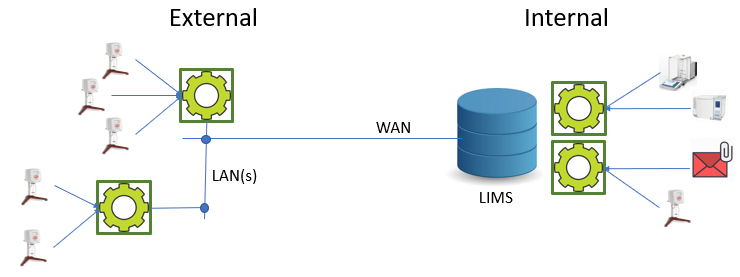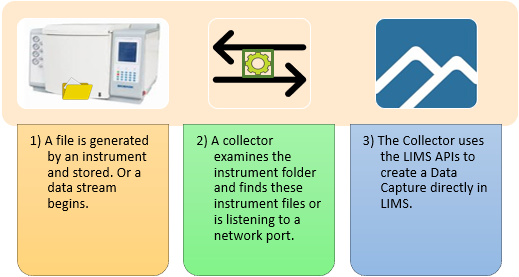Content |
||||||||||||||||||||||
|
Introduction |
|
|
|
SDMS Collectors are a component of the Scientific Data Management module. As introduced in the SDMS Overview, a Collector is responsible for securing files from one or more instruments. They might also ‘push’ this data into LabVantage. They can deliver run files from LIMS to instruments. Collectors can be deployed as an internal component of LIMS running on the app server, or as a distributed service (Windows) or daemon (UNIX). Some of the features described in this document may require additional licensing from LabVantage. |
Internal and External Collectors |
|
|
When you add a Collector to the system, you can choose an Internal or External installation mode. Internal Collectors will run on the LIMS application server. They require no further installation steps. You can simply add your Collector to LIMS and start using it. If you want your collector to run local to the instrument, you will configure the external Collector in LIMS, export the configuration, and perform some installation steps on a external host. Please see Installing External Collectors

Direct Collectors |
|
|
When you add a Collector, you can choose to configure it as either a direct or an indirect storage mode. An indirect Collector will write a file to the file system. The LabVantage automation service will later pick up that file and pull it into LIMS. A direct collector will not write a file first. Rather, it will send the required files directly to LabVantage over the network. The advantages of a direct Collector include:
- Files collected are not re-written to another potentially insecure file location
- If the Collector is internal to the LIMS application, direct storage reduces disk access since data captures are not written before transferring to the attachment repository (which might be on the same disk).
LabVantage recommends using a direct Collector when you desire synchronous behavior within LIMS and when you have smaller files or brief data streams. This is described as a 'push' method of storing this information in LIMS. The direct Collector configuration will model the data flow shown in the below diagram.

Indirect Collectors |
|
|
As mentioned above, an Indirect Collector configuration will write files to disk rather than to LIMS. An Automation engine within LIMS will later read this file and 'pull' it into a data capture record. The advantages of indirect storage include:
- Enhanced ability to automatically attempt the network transfer a second time in the case of a failure
- The option to compress the files locally on an external collector before sending through the network
LabVantage recommends using indirect storage when you have larger files and the potential for network interruptions. Alternativey, you can enable a rule on your Collector Types to "Attach by Reference". This allows you to establish a link from a Data Capture back to the original file which is retained on the Instrument's file system.
Adding or Editing a Collector |
|
|
There are two pathways to adding a Collector. One avenue is through the SDMS Collector Dashboard. Another option is through the Lab Admin site map. Navigate your menus to Lab Admin > SDMS > SDMS Collectors.
The SDMS Collectors List Page |
Use the list page to query for existing Collectors. Other options in the toolbar include:
- Add (opens the SDMS Collector maintenance page shown below)
- Edit - Choose any existing collector to modify
- List Control includes the standard functions of Copy, View and Delete
- Disable and Enable buttons will toggle the status in the "Disabled" column

| Field | Description |
| Collector Id | Unique identifier for each item |
| Description | Optional information about this Collector |
| Location | Internal or External. See the above sections for a description of the differences. |
| Storage Mode | Direct or Indirect. See the above sections for a description of the differences. |
| Disabled | A disabled collector will shut down all collector-type threads. Presumably, the instruments being monitored are not in use or are not currently generating data that needs to be secured in a repository. A Collector that has been disabled cannot be started. Any attempt to start a disabled collector will generate an Alert. |
| Paused |
A paused collector will continue to execute collector-type threads, but the emulator or collector code will be bypassed. In other words, the server will continue to allocate memory to the process but will not actually capture files. In both modes, the collector will continue to "ping" the server on a regular basis - this will enable it to start up again should that be necessary. |
| Last Started | Shows the date and time that the Collector was last rebooted. |
| Last Ping | LIMS will ping the Collector at a frequency you will define. This allows LIMS to keep track of the status of the collector. |
| Hostname | Identifier of the system where the Collector is installed. |
The SDMS Collector Maintenance Page |
From the list page, click the Add or Edit button in the toolbar to complete these fields:

| Field | Description |
| Collector Id | Unique identifier for each item |
| Description | Optional information about this Collector |
| Location | Internal or External. See the above sections for a description of the differences. If you have chosen external, please see Installing External Collectors |
| Storage Mode | Direct or Indirect. See the above sections for a description of the differences. |
| Disabled | A disabled collector will shut down all collector-type threads. Presumably, the instruments being monitored are not in use or are not currently generating data that needs to be secured in a repository. A Collector that has been disabled cannot be started. Any attempt to start a disabled collector will generate an Alert. |
| Paused |
A paused collector will continue to execute collector-type threads, but the emulator or collector code will be bypassed. In other words, the server will continue to allocate memory to the process but will not actually capture files. In both modes, the collector will continue to "ping" the server on a regular basis - this will enable it to start up again should that be necessary. |
| Allow Isolated Operation | If enabled (Yes), this setting allows the Direct Collector to continue capturing data while LabVantage LIMS application is offline. If a “Direct” Collector recognizes that LIMS is not available on the network, the Collector will temporarily switch to Indirect mode. Direct mode would send the data without creating a file first. Indirect will create the file local to the collector. LabVantage LIMS will capture that file later. When running in Isolated Indirect mode, it will continue to attempt to ping the server. Once it receives a successful response, it will revert back to Direct mode. |
| Testing Lab | Choose a Department. This allows you to enable departmental security on Data Captures and to filter the collectors presented on a Dashboard. |
| Indirect Storage Path (as seen by Collector) | Identify a directory where this Collector will write Data Captures. This path must be available to the host where the Collector is installed. Direct Collectors that do not allow Isolated Mode will not show this field. |
| Indirect Storage Path (as seen by LIMS/SDMS) | Identify a directory where LIMS will read the Data Capture and pull it into the database. This path could be different than the path above if the Collector is an external collector. For internal Collectors, the path will be the same. |
| Core Pool Size (Max 20) |
The number of threads to allocate to this collector. This should be the high-water mark for the number of instruments that will simultaneously generate data to be collected. The higher the number, the more memory will be required on your server. If the field is left blank, then one thread per instrument will be created, up to a maximum of 20 threads |
| Alert if internal storage is < Gb | Alerts about internal storage refer to available disk space on the file system where the Collector is installed. If this field is left blank, Alerts will not be raised for this issue. |
| Instruments Detail | A detail element (linkedsdimaint) presents the Instrument identifier, Description, Type, Model, Testing Lab, and Collector Type linked to this Collector. An instrument can be linked here using the Add button. However, to complete a configuration you will need to make sure you edit that instrument and configure a collector type. The Collector Type is linked to the instrument via the Instrument Model. Your license from LabVantage will restrict the number of instruments you will be permitted to connect to a Collector. |